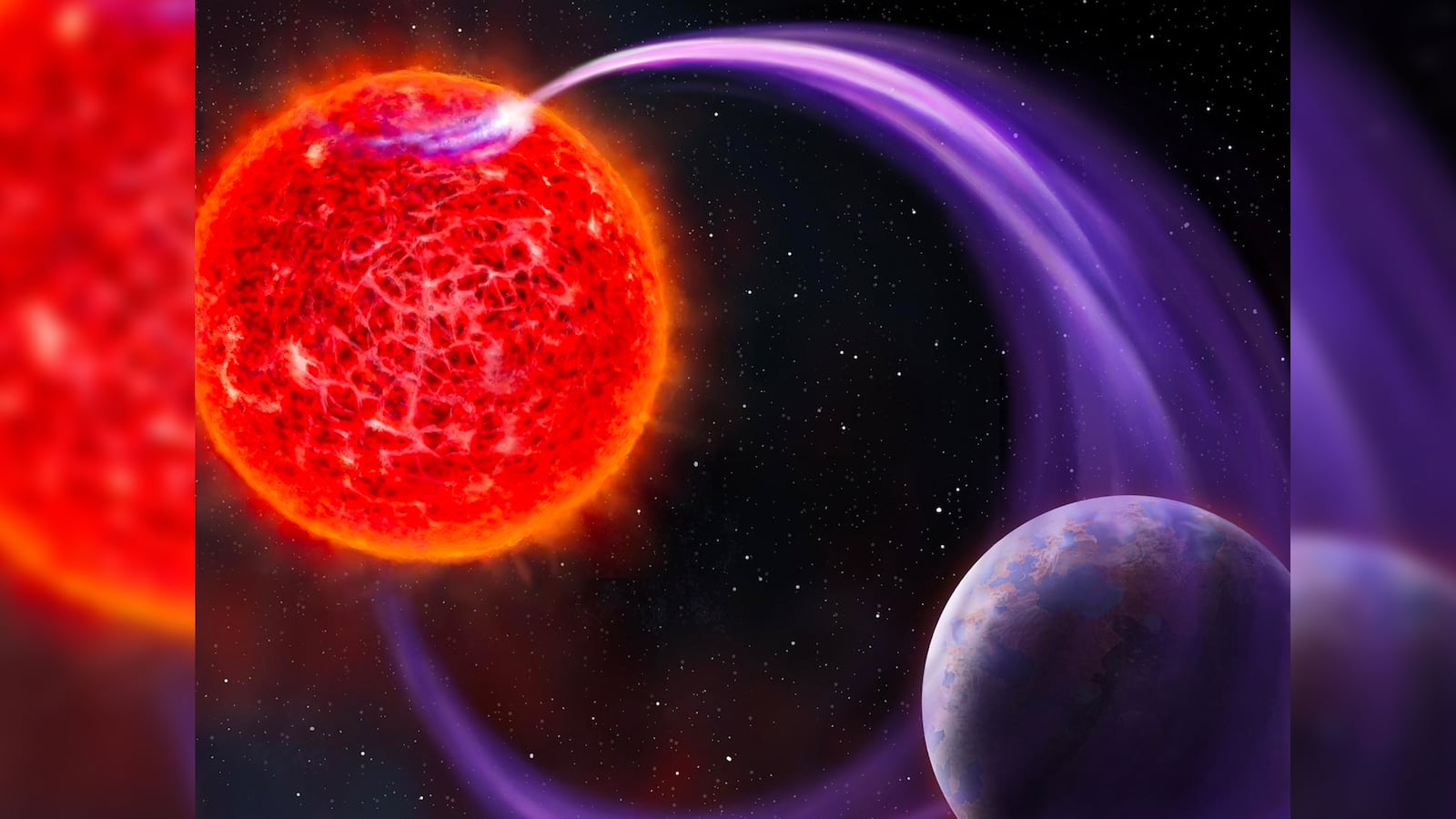On June 16, 2016, astronomers were listening to the whispers of a star 26 light years from Earth when they heard something peculiar.
Stars of all kinds emit an array of electromagnetic radiation, including radio waves. But this star, GJ 1151, is pretty calm by stellar standards and not the sort you would expect to be casting out so much radio. After running through a list of possible astrophysical suspects, scientists reckoned there was only one that made sense: these signals were coming from auroras pirouetting around the magnetic poles of the star.
This sort of shimmering iridescence was only possible if the star’s magnetic field was effectively stealing particles from a nearby world. In other words, these astronomers may have found an exoplanet (a planet outside the solar system) by tuning it to the soundtrack of its host star’s northern and southern lights.
Now, in a study published this month in Nature Astronomy, those same astronomers report that similar signals have been found around 18 other quiescent stars—and the best explanation for three of those signals is that these stars are interacting with exoplanets.
“This is a really cool technique,” said Jessie Christiansen, a project scientist at the NASA Exoplanet Archive. At present, none of these worlds have been confirmed to exist and plenty of follow-up work is needed to verify the signals are the real deal.
But if it turns out that this method of exoplanet detection works, it will give scientists a powerful searchlight to illuminate thousands of otherwise hidden worlds out there in the deep and infinite dark.
Of the 4,551 confirmed exoplanets discovered by astronomers, only a few dozen of them have been seen directly and documented through blurry photographs taken from a considerable distance. The vast majority have been found through the transit method: when the planet in our line of sight moves in front of its star, that star’s brightness dips by a detectable amount. Coming in second place is the radial velocity technique, in which astronomers measure the jiggles in a star caused by the gravitational pull of its planet, which alters the hue of the light that our telescopes drink up.
Searching for the auroras of stars to identify exoplanets would arguably be the coolest way to find them. But to understand how this might be possible, we need to run through how auroras are even made—on Earth, and then on Jupiter.
You usually need three ingredients: a world with an atmosphere, some sort of magnetic field, and a whole lot of energetic particles. Earth has all three. Electrons bursting from the sun get stolen by Earth’s magnetic field. These electrons spiral around magnetic field lines streaking out of and into its north and south magnetic poles, and ultimately ping off gas atoms and molecules in Earth’s upper atmosphere, briefly exciting them. That excitement emits flashes of light, the color of which depends on the gas being pinged.
Jupiter has auroras too, but it doesn’t rely on the sun for its supply of energetic particles. One of its moons, Io, is a volcanic extremist. This rocky world’s surface is an embarrassment of lava and sulfur; its cauldrons are in near-constant states of eruptive fury, sometimes jettisoning magmatic matter into space. When it gets there, it mingles with sunlight and becomes energized. The electrons in this volcanic soup get snatched up by Jupiter’s magnetic field lines, and when they ping off its atmosphere, some seriously powerful auroras are generated.
As those electrons spiral around Jupiter’s magnetic field lines, they emit radio waves. These waves are pretty weak until they approach the planet’s skies, at which point the electrons bunch up, interact, and unleash a potent radio signal. That signal takes the form of a radio beam, “and if that’s aligned with Earth, it is brighter than the sun” said Yvette Cendes, a radio astronomer at the Harvard-Smithsonian Center for Astrophysics in Cambridge, Massachusetts not involved with the new study.
That inspired Joseph Callingham, an astronomer at Leiden University, to look for worlds outside the solar system that might emulate this Jupiter-Io dynamic. Only in this case, Io would be an exoplanet, and Jupiter would actually be a star. The same processes would still lead to aurora igniting above the star’s poles.
The best place to look, Callingham and his colleagues thought, would be M dwarfs: diminutive, cool stars, few of which appear to be alone. “M dwarfs seem to be particularly good at making planets—and particularly good at making small rocky planets,” Christiansen, who is not involved with the new study, told The Daily Beast. Plenty of these stars are highly active, firing off stellar flares and making a lot of noise in radio. Some, however, are relatively tranquil, allowing astronomers to listen out for other sources of radio waves—including, perhaps, the sound of stellar auroras.
Callingham and his team turned to the Low Frequency Array, or LOFAR, a constellation of small radio telescopes scattered across Europe that, when combined, form a continent-size radio observatory. Last year, they reported the discovery of some low-frequency radio waves coming from a quiet M dwarf star named GJ 1151. They suspected it was coming from a star’s auroras as it scooped up particles from a planet’s atmosphere.
Another paper by the same group of scientists, published this month in The Astrophysical Journal Letters, took a fresh look at GJ 1151 with NASA’s Transiting Exoplanet Survey Satellite, or TESS, to study its activity. They found that the star was as calm as they initially thought, bolstering the notion that the radio waves are coming from auroras.
The team then used LOFAR to survey 18 other M dwarfs to look for similar signals. Most of those stars flare frequently and are cacophonous sources of radio waves. But three of them are quiet and, somehow, still emit radio waves. As they explain in their new Nature Astronomy paper, the most probable source for the radio signals emanating from these three stars is exoplanet-triggered stellar aurorae.
If these radio waves are genuinely coming from such interactions, and those planets really do exist, then this means those planets—whether they’re Mercury-size rocky pebbles, Neptune-esque ice giants, or Saturn-like gas giants—must have an atmosphere, one that is providing the star with those aurora-generating particles.

The Swedish station in the giant radio telescope LOFAR, located at the Onsala Space Observatory.
Onsala Space Observatory/R. HammargrenAnd if they have an atmosphere, those planets may also have a magnetic field. Jupiter’s moon, Io, doesn’t have a magnetic field, but it still has an atmosphere because its volcanic eruptions keep topping up its skies with noxious gases. But planets, from rocky worlds like Earth to gaseous giants like Jupiter, can have a magnetic field if something metallic like iron or hyper-compressed hydrogen is churning about in its innards.
Magnetic fields protect a planet’s atmosphere from being violently stripped away by their star’s potent solar winds—so if we are talking about a rocky world here, that has huge implications for that world’s ability to maintain an environment habitable to life. M dwarfs are prone to spewing a lot of stellar radiation through flares, so a magnetosphere protecting a planet from these menacing paroxysms would be huge, said Cendes.
Although Callingham and company’s surveys may be detecting stellar auroras, efforts to pick up the radio waves that could be emanating from exoplanets’ auroras have not yet been confirmed. But if astronomers do eventually prevail, then the presence of these planets’ magnetic fields could be confirmed. As magnetic fields probably require a planet to have an actively churning geologic viscera, this method may “actually tell us something about the interiors of these planets that are otherwise inaccessible” by other exoplanet-hunting methods, said Christiansen. And if certain radio waves could be matched up to different types of auroras colors, astronomers could figure out the compositions of those atmospheres—and whether they are amenable to life.
The signals that Callingham and company are hearing may turn out to be red herrings, said Abel Méndez, director of the Planetary Habitability Laboratory at the University of Puerto Rico at Arecibo who wasn’t involved with the study. Assuming these signals aren’t being made by alien civilizations, or sporadic flaring from the stars themselves, it could be that these radio waves are coming from Earth, from both natural processes and our own technology. “Radio frequency interference,” Mendez told The Daily Beast, “can mimic everything,” including stellar auroras.
The signals could also be coming from other astrophysical events being bounced to us off the moon. Or they could be the result of glitches from our radio telescopes. They may even be generated by some as-of-yet unknown behavior from the stars themselves.
The best way to confirm the existence of these exoplanets would be to find them through one of the other methods known to work, like the radial velocity technique. “It’s clutch if you see it two different ways. That’s much more robust,’ says Christiansen.
But this auroral method has oodles of promise. “Radio astronomy is right at the cusp at joining these traditional methods” of exoplanet detection, says Callingham. If it is proven to work, then next-gen radio telescopes, like the under-construction Square Kilometre Array, are set to find thousands of distant worlds.
For now, Callingham is content collecting these exoplanet candidates, and occasionally daydreaming about what they may be like. They are likely to have one hemisphere always facing their star, and one always facing away. The latter side wouldn’t be one of perpetual darkness, though. “You’d just have these amazing aurorae just running down constantly, just really bright,” he said. “Can you imagine the kind of civilization that would evolve and live with these constant lights?”






